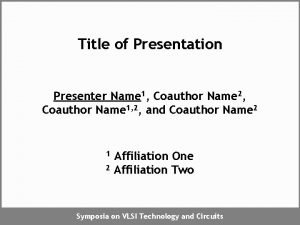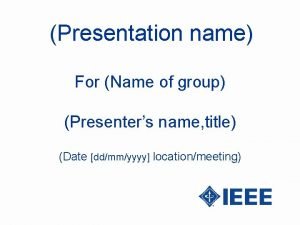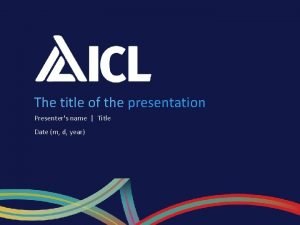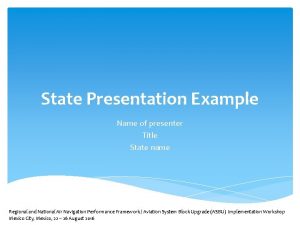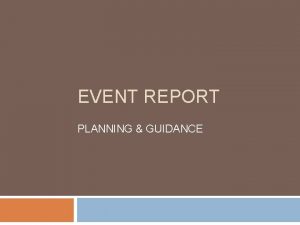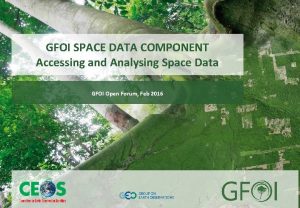GFOI Overview Name of presenter Event Location Date
















- Slides: 16

GFOI Overview Name of presenter Event Location, Date

GFOI Partners • History: Founded under Group on Earth Observations (GEO) in 2011 o o First work plan was 2012 -13 Review in 2016 led to development of Phase 2 • Lead partners: currently Australia, Committee on Earth Observation Satellite (CEOS), European Space Agency (ESA), FAO, Norway, UK, USA, Germany & the World Bank • Many other contributors including UNFCCC, IPCC, universities, technical and policy experts. • Open to new partners.


GFOI: 3 pillars of coordination

Key Updates • Greater focus on integration of partner activities across components. • Expanded GFOI office • New data component • New activities – Inventory of capacity building activities – Registry of tools – Ground Data Review – Country Needs Assesment

GFOI Organizational chart GFOI Leads Group Norway (chair)(Ellen Bruzelius Backer), Australia (Nikki Fitzgerald), CEOS (Osamu Ochiai), ESA (Frank Martin Seifert), FAO (Anssi Pekkarinen), Germany (Lena Bretas) UK (Selina Newell), US (Sylvia Wilson and Juliann Aukema) World Bank (Andres Espejo). GFOI Office Host agency: FAO Donors: Australia and Norway Capacity Building Lead Partners: FAO & SIlva. Carbon (US) Inge Jonckheere - FAO Sylvia Wilson - USGS Data Lead Partners (proposed): CEOS, WB, FAO Andreia Siqueira (Acting) - GFOI MGD Avisory group Chair: Maria Jose Sanz Sanchez R&D Lead Partner: Australia ESA Carly Green Martin Herold Sarah Carter (GOFC-GOLD,

GFOI Office The Initiative is supported by a Secretariat (the GFOI Office), which is hosted by FAO’s Forestry Department. The GFOI Office is responsible for providing secretariat services to the Initiative and to all its partners, through: ü ü active communication, programme and relationship management, organizing and hosting of events, and constructive engagement with GFOI partners.

Communications Strong global coordination in MRV is highly dependent on clear and effective communication between GFOI partners and stakeholders Enhanced communications as a means for improving coordination and collaboration between its partners.

GFOI Stakeholders Developing countries improving their forest monitoring systems and associated emissions Measurement, Reporting and Verification (MRV) practices for REDD+ and other reporting needs Map inventory of activities conducted by GFOI partners by country *Based on voluntary submissions - March 2019 Soon on: www. gfoi. org

New Data component work plan

The GFOI Cycle: identifying + addressing country needs Pre-operational R&D CALM Operational Guidance Dataset or tool etc. MGD Advisory Group MGD Operational REDDcompass CALM Pre-Operational *Criteria for consistently Assessing Levels of Maturity (CALM) Countries Country Identified Needs Capacity Building partners Training

Implementing CALM across the components Research and Development (R&D): encourages their community to report the status of their research using CALM in order to communicate progress toward operational status. Uses information to highlight gaps in research to achieve operational ready technology The Methods and Guidance: Utilises CALM in assessing and prioritizing the development of new guidance on pre-operational/operational concepts. Data component: uses CALM to communicate the maturity levels of data platforms and tools that help bridge the gap between scientific and technological developments and country MRV needs. Capacity Building communicates maturity level through the development of training materials and may use information to advise countries on building capacity and systems that use technologies that are considered operational.

Ground Data Review Goals: identify options for GFOI to facilitate increased global coordination in the provision of support and guidance in the collection, storage and use of ground data in the context of a NFMS that benefits developing countries Scope of Review: Existing GFOI Guidance, partner support, tools, data sets and other products Timeline: * TOR and implementation approach discussed and refined at the GFOI Plenary in April * Inception report drafted: June 2019 * Review conducted: July-September * Draft report sent out for comments: end of September * Review complete and recommendations provided to GFOI for consideration at the final face-to-face Leads meeting for the year: approximately, the November timeframe.

Country Needs Assessment Goals: To develop a holistic process for supporting developing countries to assess their National Forest Monitoring Systems (NFMS), and associated emissions MRV procedures, in order increase national coordination, identify and prioritize improvements and communicate needs to both national decision makers and GFOI partners for international support The CNA Process: 1. Should be geared toward developing country led assessments 2. Should consider priority goals of NFMS and focus needs assessment on these goals 3. Development and implementation of CNA process should include participants from all of the components. 4. Be flexible to take into account different regional and country needs and situations. 5. Include clear tools and processes for clearly communicating the results of the assessment to national stakeholders and international partners.

Country Needs Assessment Lessons learned from regional pilots: Two regional meetings were held in Asia (5 countries) and Africa (6 countries) to trial an interactive card based system for using the REDDcompass to pilot the methods. Workshop included small country teams with the goal of these teams following up with other nationals in country. 1. A holistic process will generally take time and involve multiple steps working with relevant country institutions 2. Active follow up required with country teams 3. Further development of templates or tools to improve communication of results to national stakeholders and funders and capacity building organizations. Further follow up will take place during GFOI plenary

Want more? gfoi. org facebook. com/gfoi 1 twitter. com/gfoi_forest office@gfoi. org
 Name teachers name class date
Name teachers name class date What is your class teacher name
What is your class teacher name Name class date
Name class date Record date dividends
Record date dividends What is ex dividend date
What is ex dividend date Presenter title
Presenter title Presenter's name
Presenter's name Title of presenter
Title of presenter Presenter name
Presenter name Presenter name
Presenter name Presentation name
Presentation name Presenter's name
Presenter's name What is the name of the presenter
What is the name of the presenter Session title examples
Session title examples Presenter name
Presenter name Younique presenter ms name
Younique presenter ms name Name of presentation
Name of presentation





